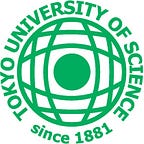Clear as (Quasi) Crystal: Scientists Discover the First Ferromagnetic Quasicrystals
Long-range magnetic order has been observed in quasicrystals, strange solids that show forbidden crystal symmetries, for the first time
Since the discovery of quasicrystals (QCs), solids that mimic crystals in their long-range order but lack periodicity, scientists have sought physical properties related to their peculiar structure. Now, an international group of researchers led by Tokyo University of Science, Japan, report for the first time a long-range magnetic order in QCs with icosahedral symmetry that turn ferromagnetic below certain temperatures. This groundbreaking discovery opens doors to future research on these exotic materials.
In 1984, a routine examination of an aluminum-manganese alloy revealed a curious anomaly that was previously thought to be crystallographically impossible– a five-fold rotational symmetry. This was the discovery (later recognized by Nobel Prize) of a “quasicrystal” (QC), a curious solid that shows long-range ordering similar to crystals but lacks their periodicity. Rather, the order is “quasiperiodic,” which leads to some exotic symmetries absent in crystals. Ever since then, QCs have been the subject of enormous scientific interest.
But their potential applications remain uncertain since no physical property signifying their long-range quasiperiodic order, such as long-range magnetic order, has been observed. Until now, that is.
In a new study published in the Journal of the American Chemical Society, a global team of scientists led by Professor Ryuji Tamura of Tokyo University of Science (TUS), Japan, Professor Taku J. Sato of Tohoku University, Japan, and Professor Maxim Avdeev of the Australian Nuclear Science and Technology Organisation and University of Sydney, Australia, have reported the first-ever observation of long-range ferromagnetic order in icosahedral quasicrystals (i QCs or QCs with 5-fold rotational symmetry). Ms. Asuka Ishikawa and Dr. Shintaro Suzuki, members of the Tamura Laboratory at TUS, also made invaluable contributions to the project.
“This successful synthesis of ferromagnetic i QCs is the culmination of more than 10 years of research in our laboratory,” says Prof. Tamura, “Nobody knows what kind of peculiar behavior they will further reveal or how they can be exploited for the advancement of technology, but now we have finally taken the first step. Elucidating the properties of these ferromagnetic QCs will contribute greatly to the development of science.”
There are four major types of magnetic order: ferromagnetism, antiferromagnetism, paramagnetism, and diamagnetism. The discovery of antiferromagnetic and ferromagnetic transitions in approximant crystals (APs) — crystals with a somewhat similar structure to the related QCs that can be studied using conventional techniques — inspired the research group to look for magnetically ordered i QCs. For their research, the team prepared alloys of gold (Au), gallium (Ga) and gadolinium (Gd) and gold, gallium, and terbium (Tb). Using conventional X-ray diffraction, they observed the formation of an icosahedral quasicrystal phase for both Au-Ga-Gd and Au-Ga-Tb.
They then investigated the properties of the two i QCs using magnetic susceptibility and specific heat measurements. They found that both alloys showed a ferromagnetic phase transition at 23 K (Gd i QC) and 16 K (Tb i QC), a signature of long-range magnetic order. To further validate these results, they performed neutron diffraction experiments using ECHIDNA (ANSTO, Australia) and ISSP-GPTAS (JRR-3, Japan), and looked at the neutron diffraction patterns of the i QCs at different temperatures. They observed prominent Bragg peaks below their respective transition temperatures, confirming the ferromagnetic nature of the i QCs.
Attempts to synthesize magnetic i QCs until now have all ended in “spin-glass-like freezing,” characterized by a disordered magnetic state. Against this backdrop, the discovery of long-range ferromagnetic order in this study has consequences far beyond the landscape of the physical properties of materials and opens doors to tailored magnetic materials. “The crystal symmetry of ferromagnetic QCs is much higher than that of conventional periodic crystals, which makes it possible to apply them as ultrasoft magnetic materials,” says Prof. Tamura.
With the decades-long quest for long-range magnetic order in i QCs finally at an end, the world is now eagerly waiting to see what this groundbreaking discovery entails. With such superlative research pioneering the way, it won’t be long before we find out!
Reference
Authors: Ryuji Tamura (1), Asuka Ishikawa (2), Shintaro Suzuki (1), Akihiro Kotajima (1), Yujiro Tanaka(1), Takehito Seki (3), Naoya Shibata (3), Tsunetomo Yamada (4), Takenori Fujii (5), Chin-Wei Wang (6), Maxim Avdeev (7,8), Kazuhiro Nawa (9), Daisuke Okuyama (9), and Taku J. Sato (9)
Title of original paper: Experimental observation of long-range magnetic order in icosahedral quasicrystals
Journal: Journal of the American Chemical Society
DOI: https://doi.org/10.1021/jacs.1c09954
Affiliations:
- Department of Materials Science and Technology, Tokyo University of Science
2. Research Institute for Science and Technology, Tokyo University of Science,
3. Institute of Engineering Innovation, School of Engineering, The University of Tokyo,
4. Department of Applied Physics, Tokyo University of Science,
5. Cryogenic Research Center, The University of Tokyo,
6. National Synchrotron Radiation Research Center,
7. Australian Nuclear Science and Technology Organisation,
8. School of Chemistry, The University of Sydney,
9. Institute of Multidisciplinary Research for Advanced Materials, Tohoku University.
Further Information
Professor Ryuji Tamura
Department of Materials Science and Technology,
Tokyo University of Science
Email: tamura@rs.tus.ac.jp
Professor Taku J. Sato
Institute of Multidisciplinary Research for Advanced Materials
Tohoku University
Email: taku@tohoku.ac.jp
Professor Maxim Avdeev
Australian Nuclear Science and Technology Organisation
Email: max@ansto.gov.au
Media contact
Tsutomu Shimizu
Public Relations Divisions
Tokyo University of Science
Email: mediaoffice@admin.tus.ac.jp
Website: https://www.tus.ac.jp/en/mediarelations/
Institute of Multidisciplinary Research for Advanced Materials
Tohoku University
Email: press.tagen@grp.tohoku.ac.jp
Phil McCall
Australian Public Affairs
Australian Nuclear Science and Technology Organisation (ANSTO)
E-mail: pmccall@ansto.gov.au
Funding information
This work was supported by JSPS KAKENHI Grant Numbers JP19H05817, JP19H05818, 21H01044 and 20H05261. This work was partly supported by the research program “Dynamic Alliance for Open Innovation Bridging Human, Environment, and Materials”. The travel expenses for the neutron scattering experiment at ANSTO, as well as the experiment at JRR-3, were partly supported by the General User Program for Neutron Scattering Experiments, Institute for Solid State Physics, University of Tokyo.
